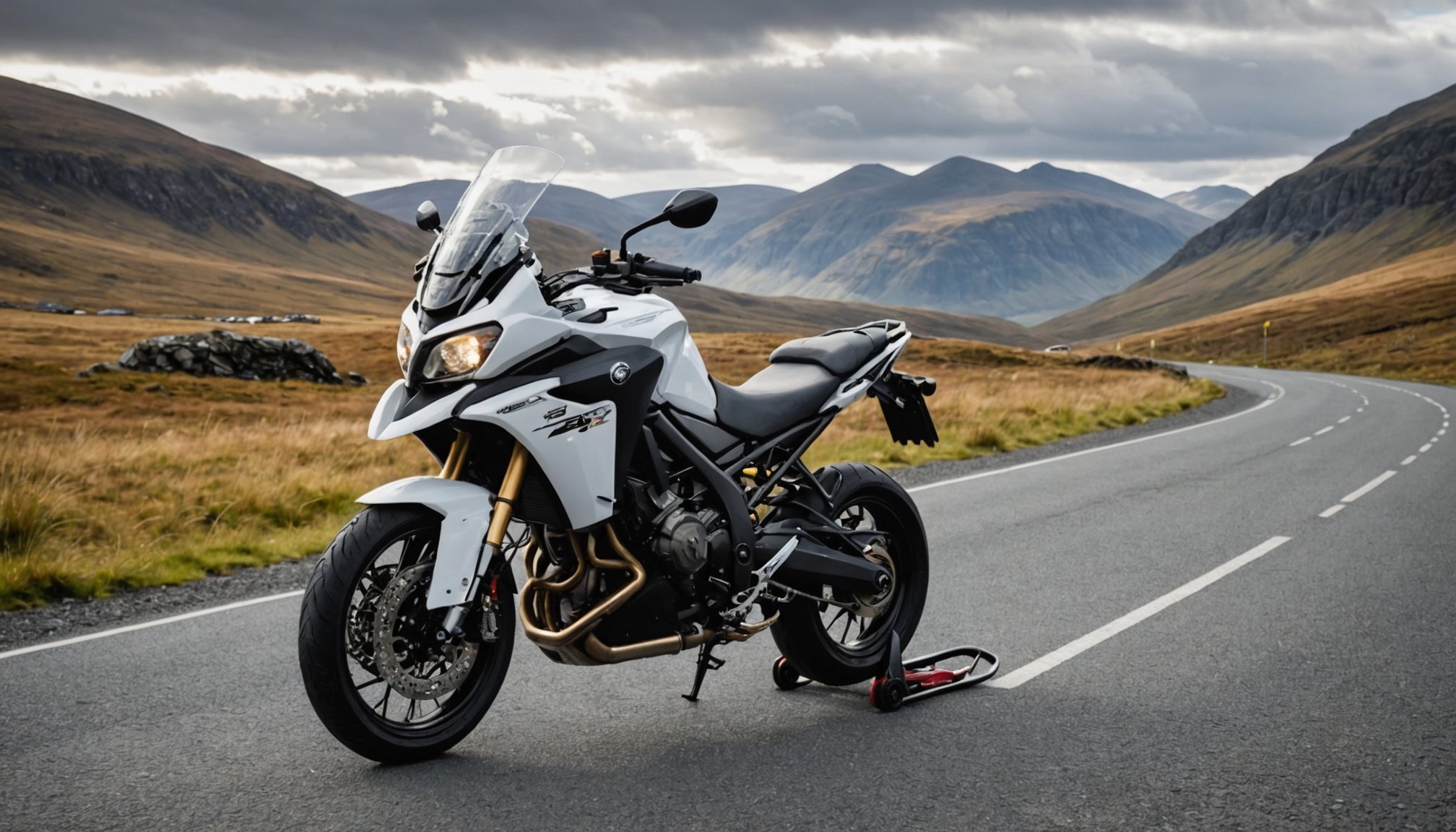Essential Maintenance Checklist
Before every ride, conducting a thorough pre-ride inspection is paramount. This helps ensure your sport bike’s optimal performance and safety. Focus on essential components such as brakes, tires, and the engine. Pay special attention to fluid levels, as they ensure smooth operation.
When preparing your bike for high-altitude journeys, adjustments in maintenance are necessary. At higher altitudes, bikes often require tweaks to achieve optimal performance. Key areas needing focus include the carburettor and air filters. Ensuring these components are calibrated for thinner air can prevent performance dips.
Have you seen this : Top-Rated Anti-Theft Alarm Systems for Sport Bikes in the UK: Secure Your Ride!
For regular sport bike maintenance, adhering to a checklist can prolong your bike’s life. Essential tasks involve:
- Regular oil changes to maintain engine health
- Checking and adjusting tire pressure for stability and grip
- Lubricating the chain to prevent wear
Performing these tasks not only guarantees better performance but also enhances the longevity of your bike. Prioritising these maintenance tasks can make a significant difference in ensuring every ride is smooth and trouble-free.
In parallel : Top Strategies for Preventing Sport Bike Overheating During UK Traffic Jams
Necessary Gear for High-Altitude Riding
When embarking on high-altitude journeys, riding gear becomes critical for both safety and comfort. Conditions can vary significantly with altitude, making it essential to equip yourself with the right altitude riding gear.
First, consider the core elements of your gear. A well-fitted helmet is non-negotiable, ensuring head protection. Jackets and pants made from breathable yet protective materials provide insulation and safety. Ventilation is key, as temperatures fluctuate dramatically in higher altitudes. Layering also plays an essential role in adjusting to these changes, with base layers helping to maintain body warmth without restricting movement.
Footwear designed to support and protect during altitude riding is a must. Look for boots with sturdy ankle support and water-resistant features. Since weather can be unpredictable, gear should include waterproof gloves and thermal socks, which help maintain comfort and dexterity in the cold.
Additionally, safety equipment like knee and elbow guards are recommended. This protective gear mitigates risks involved with potentially rough terrain. Finally, a reliable hydration system is vital; dehydration risk increases at higher altitudes. By selecting the right gear, riders can enhance their safety and comfort, enjoying the journey without compromising their well-being.
Altitude Acclimatization Strategies
Riding at altitude can significantly impact physical performance, as the reduced oxygen availability strains the cardiovascular system. Recognizing the body’s response to such environments is crucial to avoid compromising one’s health.
Tips for Acclimatization Before the Journey
Before tackling high altitudes, engage in altitude acclimatization by gradually exposing yourself to higher elevations. This is essential to allow the body to build a tolerance to low-oxygen environments. Begin by spending time at intermediary altitudes, breathing deeply, and staying hydrated. Hydration aids in maintaining optimal oxygen saturation levels, which is crucial for your well-being.
Signs of Altitude Sickness to Watch For
While riding at altitude, it’s imperative to remain vigilant about symptoms of altitude sickness. These may include headaches, nausea, or dizziness. Should you experience these warning signs, it is important to descend to a lower altitude immediately and rest. Remember, prevention is key; by slowly acclimatizing and listening to your body, you can enjoy your high-altitude experiences safely and effectively. Prioritise your health by staying informed and prepared to tackle challenges with confidence.
Recommended Routes in the Scottish Highlands
Embarking on a journey through the Scottish Highlands promises stunning landscapes and unforgettable experiences for cycling enthusiasts. Among the most popular scenic routes are the North Coast 500 and the Loch Lomond to Loch Ness path, renowned for their breathtaking views and unique challenges.
When selecting a trail, it’s crucial to match the route with your skill level. Beginners might prefer the gentle gradients and well-paved paths of routes such as the Great Glen Way, which offers ease alongside stunning scenery. Intermediate and advanced riders might find joy in the more demanding climbs and rugged paths of the Highland Perthshire Loop, which requires a higher degree of fitness and technical skill.
Understanding the local traffic laws is vital for a safe adventure. In the Highlands, cyclists should be aware of single-track roads, passing places, and the tendency for wildlife to make unexpected appearances. Additionally, be mindful of weather conditions; they can change rapidly, impacting both the terrain and your riding experience.
Planning your ride by considering your capabilities and the logistical demands of each trail ensures a rewarding and smooth journey through this exceptional region.
Safety Precautions for High-Altitude Riding
Engaging in high-altitude riding can be thrilling, but it comes with unique risks. The lower oxygen levels at higher altitudes may lead to symptoms like dizziness, headaches, and altitude sickness, which can impair judgment and riding ability. Understanding these risks is crucial for ensuring riding safety.
To mitigate these risks, preparation is vital. Acclimatise gradually to increased altitudes. Plan your journey to include frequent breaks, allowing your body to adjust to the changes. Staying hydrated is essential, as dehydration can exacerbate altitude sickness symptoms.
Another effective strategy is to travel with a buddy or group. This provides a support system in case of an emergency. Group riding offers a safety net, with someone to monitor your condition and assist if needed.
A few additional safety tips include checking your motorcycle’s performance since the air is less dense at higher altitudes. Engines may perform differently, so monitor your bike’s behavior and ensure it is serviced before departure. Moreover, carrying a first aid kit and a reliable communication device is important for safety. Taking these precautions can ensure an enjoyable and safe riding experience in high-altitude areas.
Local Weather Considerations and Planning
Planning a journey through the Scottish Highlands requires a thorough understanding of the local climate, which can significantly impact your riding experience. The weather in this region is famously unpredictable, with conditions varying dramatically even over a short period. To ensure a safe and enjoyable trip, recognising the potential challenges posed by the weather is essential.
Weather planning involves preparing for sudden changes such as rain, wind, or fog. Riders must be equipped for these shifts in conditions, which may occur with little warning. It is wise to pack versatile gear, including waterproof clothing and layered outfits, to adapt to diverse weather situations effortlessly.
To keep current with the forecast while on your adventure, several apps can provide real-time weather forecasts. Tools like the Met Office Weather app and BBC Weather offer updates specific to the Scottish Highlands. These apps aid in decision-making and route adjustments, ensuring optimal riding conditions.
By staying informed and preparing for the variable riding conditions, you can maximise your safety and enjoyment in this stunning, yet unpredictable, region. Making smart use of technology and understanding local weather patterns are vital steps in your Highland riding adventure.
Personal Anecdotes or Expert Insights
Riding a motorcycle at high altitude presents unique challenges and exhilaration. My personal journey through the winding roads of the Andes was an eye-opener. The air thins, demanding more from both rider and machine—it’s a test enhancing skills and patience.
Expert Tips
- Preparation is Key: Ensure your bike is well-maintained; altitude can affect engine performance. Mechanics often recommend adjustments to fuel injection or carburettor settings.
- Acclimatise Slowly: This prevents altitude sickness; experts suggest gradual ascension to let your body adjust.
- Dress in Layers: Weather conditions are unpredictable. A sudden temperature drop at higher elevations is not uncommon.
These expert insights are drawn from seasoned riders who have encountered, and successfully navigated, such terrains. Their wisdom highlights the importance of preparation and awareness.
Lessons Learned
From my personal riding experiences, I learned the significance of staying calm under pressure. Mechanical hiccups are amplified at higher altitudes, and being mentally prepared is as crucial as physical readiness. New riders can benefit significantly by internalising these lessons, making their high-altitude rides safer and more enjoyable. With careful planning and respect for the environment, the sense of achievement is unparalleled.











